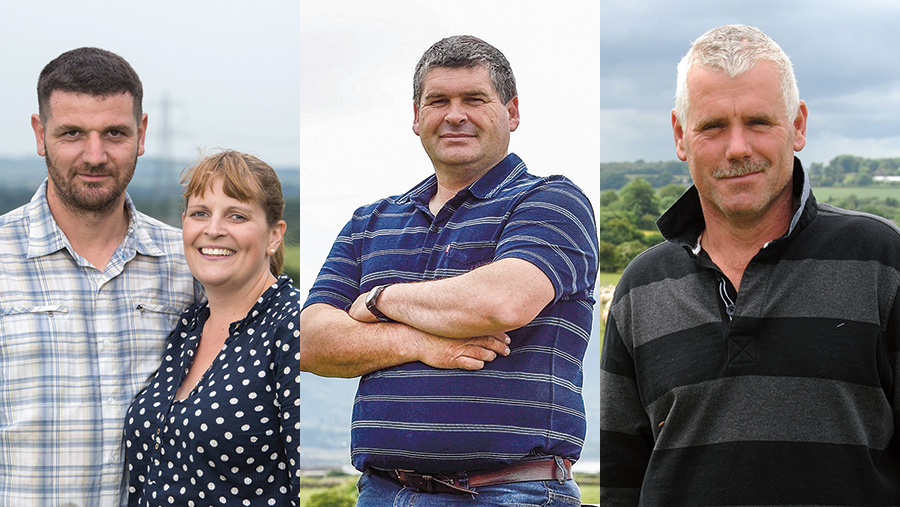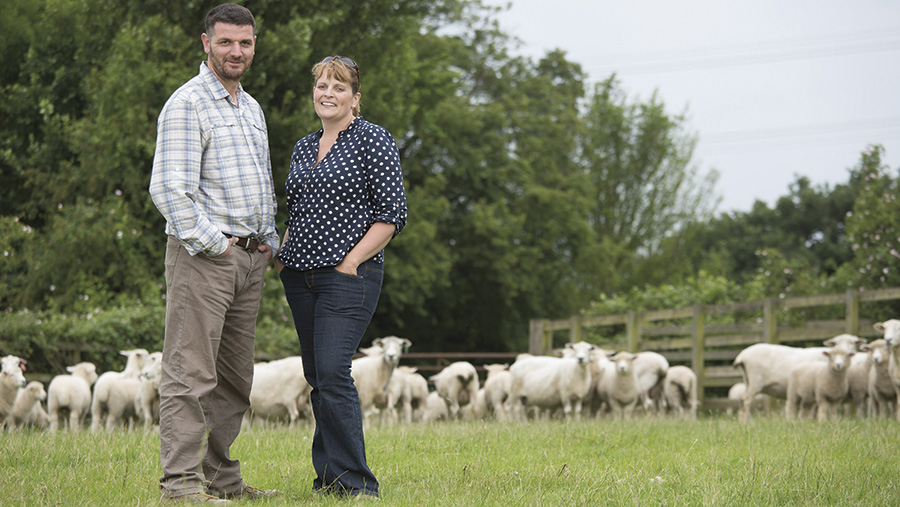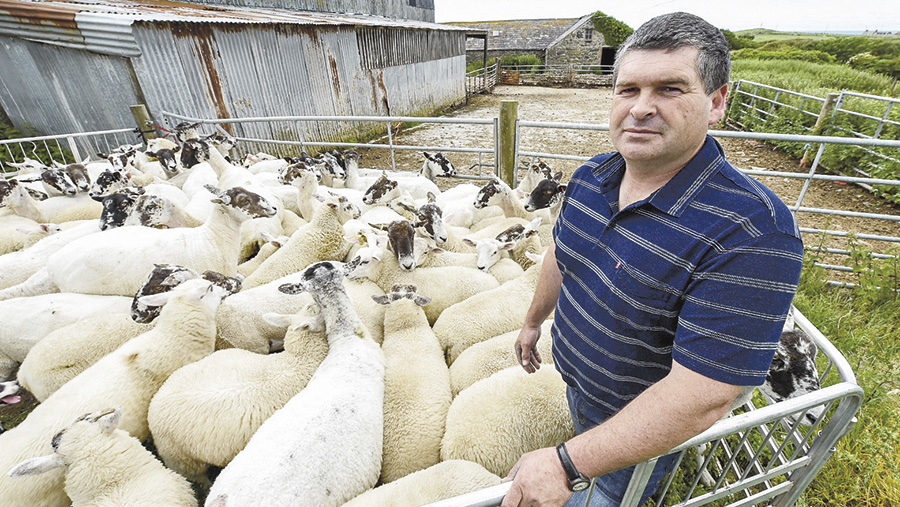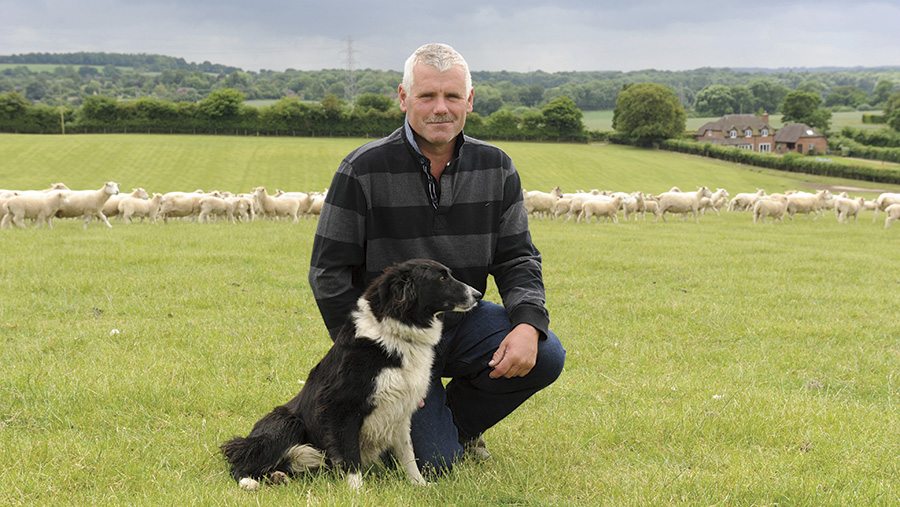2016 Farmers Weekly Awards: Sheep Farmer finalists revealed

From left: Rob Hodgkins and Jo Franklin, Deio Hughes and Gordon Wyeth
Extensive, low-input systems based on strong maternal genetics and outdoor lambing make up our shortlist.
With teamwork, market knowledge and negotiating skills, the result is three sustainable businesses. Michael Priestley reports
Rob Hodgkins and Jo Franklin
Kaiapoi Romneys, Hertfordshire
In just four years Rob Hodgkins and fiancée Jo Franklin have turned 200 draft ewes, a 10-year-old horsebox and a 16-year-old Prattley into one of the cheapest and most efficient lamb production models around.
Now running 1,200 breeding ewes in 2016 on a forage-only outside lambing system, the pair have managed to build up a rented land base of 263ha across 13 blocks including 80ha of solar panel grazing, producing wether lambs finished on cover crops and stubble turnips on contract for Tesco, and surplus ewe lambs for breeding.

© Tim Scrivener
Combining an engineering degree and Basis and Facts agronomy qualifications, the two Nuffield scholars make a dynamic duo and it is their academic and professional backgrounds that helped their still-growing business – Kaiapoi Romneys – in its fledgling stages.
Add in the New Zealand Romney as a specialist forage converter and a pragmatic approach to rental agreements and their business is essentially a blueprint for an expandable system that can grow to match their four-year plan of 2,020 ewes by 2020 and beyond.
The low-cost system produces “supermarket sheep” averaging a circa 20kg carcass to grade at R3L and a return of £74.60 last year, with breeding ewe lambs bring a return of £100 a head.
The judges liked
- Cornered a niche in the land market
- Clear short- to long-term business plan to develop the farm until 2020 and beyond
- Opportunistic use of solar farms
- Cost-effective weed control
- Using good-quality forages in low-cost system
- Industry involvement and collaboration with Tesco
Margins such as this are critical as Rob and Jo do not pick up any subsidy payments.
The path to success and profitability has been a whirlwind chain of events started in 2012, when Rob was still farming at home near Brighton at Wairere Romneys.
He opted to take his inheritance early in the shape of mature sheep, leaving the family business to his father and younger brother.
After 18 months of farming a growing sheep flock on evenings and weekends and designing clutches for Ford during the week, Rob finally felt the time was right to chase his dream and commit to farming full-time in 2014.
The business has been able to benefit from genetics from Wairere sires, providing dependable stock with more than 20 genomic markers for attributes including faecal egg count score, dag score, lamb growth rate and meat yield.
Similarly, a 330ha arable tenancy taken on by Jo in 2014 has provided their expanding flock with enough (3.4ha) forage-producing ground.
Their barn for orphans and adoptions is a 20-minute drive from home, leading to Jo giving them a Kiwi-style early weaning this year.
This was done at five weeks with lambs over 9kg, while lambs on nine-year-old ewes were weaned at 70-80 days to help ewes gain body condition.
Furthermore, by introducing sheep to wheat-focused arable rotations in the South East, their business is expanding the options available in a region suffering crippling blackgrass infestation, declining organic matter levels and the loss of oilseed rape as a break crop amid the rise of cabbage stem flea beetle.
Farm facts
- 263ha rented on annual grazing licences
- 1,200-head New Zealand Romney flock
- AHDB Beef and Lamb monitor farm
- No government subsidy
- Part of the Tesco Sustainable Lamb Group steering committee
The opportunistic approach to picking up higher-level stewardship ground has extended to grazing under solar panels, boosting the environmental credentials of the operation and allowing Rob to plug a summer feed gap to maintain lamb growth rates.
“Friends jokingly dub me a tarmac farmer as I have to spend so much time driving between different blocks of land,” says Rob, who deals with 13 grass and five forage landlords.
“There’s a niche we can exploit in this area of the south-east, with much scepticism from other graziers about using solar panel ground but we’re finding a fit for it in our system and making it work for us.”
One 30ha AHDB Beef and Lamb grant-funded solar panel site has been trial-drilled with a seed mix of three small- to medium-leafed clovers (1.25kg/ha), an alsike (1.25kg/ha) and 4kg of plantain with the intention of providing a high-protein lamb finishing forage.
Great initiative has been shown in weed and pasture management in order to bring tired hay ground and neglected pasture up to scratch.
Jo’s agronomy skills are used to maximise the potential of the ground they take on – often old hay ground with only 60% sward cover.
Jo uses a three-step approach on new land: she checks soil indices and leaf tissue analysis and makes any adjustments necessary; she spot-sprays nettles and weed-wipes thistles; and she uses a tined harrow and overseed with grass or clover as necessary.
Deio Hughes
Ty Mawr, Gwynedd
Faith in hardy maternal genetics and a great eye for stock has propelled the organic lamb produced by contract/share-farmers Deio Hughes and fiancée Margaret on to the world stage.
What is more, the low-cost outdoor lambing system in operation at Ty Mawr Farms, Caernarfon, is hugely profitable, prompting landlord Lord Newborough of the Rhug Estate at Corwen to offer more land under the agreement.

© Richard Stanton
In just 10 years, Ty Mawr Farms has grown from an 800-head Beulah flock on 233ha to 1,250 North of England Mules and a 185-head suckler herd on 586ha.
By combining the prolificacy and maternal ability of the North of England Mule with terminal sires, Deio has mastered a system resilient enough to function without farm subsidy and produce in excess of 2,200 lambs annually.
Furthermore, adding another 1,200 store lambs bought in the autumn results in a 10- to 11-month production chain supplying a minimum of 60 lambs a week to the Rhug.
The judges liked
- Supplying a steady flow of lambs for 11 months of the year – 60 a week
- Strong biosecurity and quarantine protocols
- Sound market understanding
- Business model is a great blueprint for other landlords
- Using high output genetics in a low-input system
But in spite of such impressive production levels, Deio stresses that quality is key.
The Rhug’s set price has stood at £4.50/kg for the past two years. Lambs are reared to hit an 18kg carcass as a minimum, with progeny averaging 20-22kg.
Surplus lambs are sold through Dunbia, St Merryn and Waitrose. No creep or concentrate is fed to lambs, which are finished on a mix of clover, chicory or stubble turnips.
Mules are put to a Beltex cross Texel or a Texel sourced from either Builth Wells, a small home-bred flock, or bought from Cockermouth. About 30 of the 50 Ty Mawr tups are cross-bred as part of Deio’s efforts to find the ideal balance between lamb size, length and conformation.
“I believe from now on there is going to be major emphasis on the quality of UK lamb in order for us to compete,” says Deio.
Lambs are produced to Soil Association standards with all store lambs (sourced 50:50 from Northumberland and Wales) needing to fit organic specification.
About one-third of Ty Mawr lambs can be marketed as salt marsh lambs and are shipped as far afield as London and Dubai to be eaten in top-end restaurants.
Switching to the Mule over a period of five years has seen scanning rates lift from 150% to 190%. Deio is now a recognised face at Cockermouth Mule sales after testing the Mules abilities with a batch of Swaledales he crossed with a Bluefaced Leicester to ensure confidence in the breed’s ability at home.
Farm facts
- Share/contract farming 586ha organically
- 1,250 North of England Mules
- Beltex-Texel sires
- Producing 60-90 lambs weekly for Rhug Estate
- With so much stock entering the farm in the form of 300 Mule shearlings and 1,200 Texel cross Mule store lambs, biosecurity has to be sound.
One enzootic abortion vaccination is given to all bought shearlings in September and Nitroxynil injections, at £4 a head, are issued in September and January to breeding stock. Deio and Margaret are finding fluke is not a problem on what can be a wet farm since converting to the Mule.
Lameness cases are minimised with a strict “one chance” culling policy for any ewes with foot-rot or contagious ovine digital dermatitis, with antibiotics used to address problems.
Formalin foot-baths, a sheep scab inspection and fluke treatments are given in the first week stock comes on farm in a cooling-off period.
Breeding shearlings are then quarantined for five to six weeks through October and mated on a separate part of the farm and first mixed with the rest of the flock after scanning on 25 February.
Flock performance is then monitored on Agridata, a “simple but effective” program Deio and Margaret have been using for nine years.
Ewes are challenged to maximise nutrition from their environment.
Currently, 3t of minerals buckets and 1t of organic feed blocks are fed ab-lib all year.
This expense addresses pockets of selenium and cobalt deficiency on the farm but it is not hurting margins which, when accounting for earnings from the store lambs, yielded a net margin of £85 for each of the 1,150 ewes on the farm in 2015.
Meanwhile, fixed costs are kept low by using a local contractor for slurry injection, fencing, big baling, ploughing and hedgecutting.
“As things stand, if subsidy payments were to be stopped I believe we could still manage a healthy profit here at Ty Mawr,” reasons Deio. “I believe the future looks good in farming.”
Gordon Wyeth
Maple Farm, Hampshire
Hampshire sheep farmer Gordon Wyeth is testament to how investing time and faith in staff and embracing new ideas can build a successful business.
A former sheep shearer, Gordon has had his fair share of setbacks but overcame adversity to build a thriving and sustainable sheep and lamb production system.

© Hugh Nutt
Over his working life he has steadily increased numbers from a schoolboy hobby flock to a 9,500 New Zealand Romney breeding enterprise, of which 2,000 are contract shepherded.
Ably assisted by his family partnership of wife Glenys and mother Jennifer, Gordon employs four full-time workers, including son Jack.
A career spent travelling southern England and Scandinavia on a 60,000 ewe a year shearing run has given Gordon valuable insights into different farming styles.
His system has pounced on the affordable grazing leases in his region and requires 60-70 miles of electric fencing.
Varied grazing habitats are managed by adjusting stocking rates from between eight to nine dry sheep/ha on higher-level stewardship ground through to 18-19 ewes a hectare on better land.
What the judges liked
- Very impressive lambs reared to scanning ratio
- Co-ordination of several well-managed enterprises
- Forging a profitable and expanding business against adversity
- Grassland management has spawned a hay enterprise
- Managing stocking rates to control grass growth
But the road to success hasn’t been smooth. In 2003 Gordon was forced to sell his flock as culls when an abortion outbreak of Border Disease left 800 of his 2,000 ewes barren and this winter he lost 116 in-lamb ewes in what was dubbed the UK’s worst dog attack.
However, both were turned into opportunities.
The abortion issue resulted in a switch from traditional Mules to the New Zealand Romney, while the dog attack led Gordon to speak out about the importance of keeping dogs on leads.
Abortion is now history because of being a closed flock, testing for abortion and having faith in the New Zealanders’ “survival of the fittest” approach.
Similarly, the challenge of managing more than 1,000ha of grassland has been fashioned into a lucrative hay-making enterprise, turning £150,000 in its first year last summer.
“There are 40,000 horses in a 15-mile radius,” explains Gordon, who already has a customer base of 150 stable yards.
Gordon’s mantra is “find the worker, then find the work” and he puts a high value on his staff’s input.
Regular time is put aside to share opinions and discuss the farm’s operation and this has allowed the business to develop, expand and seize opportunities.
“Staff are trained to do their job as individuals and must be able to show initiative,” stresses Gordon, who has a morning meeting and a rough plan each day to share tasks.
Farm facts
- 9,500 New Zealand Romneys
- 1,011ha, of which 850ha is on grazing licences
- Breeding stock: Sell 1,500 shearling and 1,000 ewe lambs
- Market 5,000 fat lambs to ABP most grading at R4L
- 700 Shetland-cross store lambs
- 230 goats
Barren rates sit at just 1% with ewes challenged to scan at more than 170% and rear a minimum of 150%. This year the flock will rear 155%.
He attributes this to sourcing the top 1% of sires from Wairere Romneys, culling unproductive sheep and maintaining body condition on ewes by shearing twice a year (mid-May and late September) and feeding ad-lib fodder beet on grass prior to tupping to boost conception rates. This year’s gross margin a ewe stands at an impressive £72 compared to an AHDB Stocktake average of £55.
Gordon sells about 1,500 breeding shearlings and 1,000 ewe lambs a year. Their popularity is based on their ability to perform in low-cost systems, lambing outside from 1 April, with ewe lambs starting around 20 April.
“The Wairere bloodline is really working for us,” says Gordon, who notes lambs are excellent at getting up and sucking.
Returns from ewe lambs are maximised by putting them to a Shetland for ease of lambing and their crossed lambs sold as stores or sold fat for £50.
Lambs from the main commercial flock yield carcasses of 17-18kg with 85-90% achieving an R grade from a forage-only diet.
Sheep undergo intense scrutiny and the commercial flock is benchmarked through use of EID technology and an autodrafter.
Scanning results, grading sheets and weaning weights are among the metrics Gordon and the team use to inform breeding decisions.
The 2016 Farmers Weekly Sheep Farmer of the Year Award is sponsored by Greencoat Farm.
![]() “Teamwork and passion are strong attributes shared by the finalists. Rob and Jo complement each other well as an engineer and an agronomist. Gordon has a great family network and nurtures his staff, and Deio is managing an extensive outdoor lambing system with minimal labour”
“Teamwork and passion are strong attributes shared by the finalists. Rob and Jo complement each other well as an engineer and an agronomist. Gordon has a great family network and nurtures his staff, and Deio is managing an extensive outdoor lambing system with minimal labour”
Mike Stanyon
Senior sales manager, Greencoat Farm
Farmplan software

Farmplan offers a range of livestock equipment enabling you to read cattle tags out on farm as well as check and update animal details. Find out more.
